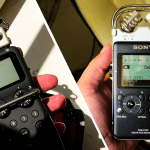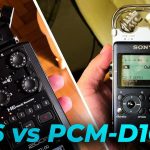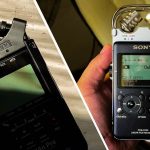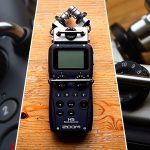In this article I am going to talk about my opinions on the Sony PCM-D100, what I like about it, what I don’t, what it’s good for, and what it can do for you. First, let’s get into what I like about it.

Noise
One of the most common things you’ll hear about this recorder is how great it is for recording quiet sound sources, due to it’s quality pre-amps and exceptional built-in microphones.
This comes in handy when recording outdoor ambiences, or when you make a mistake setting the levels, and you need to boost the signal a bit.
Now, if you do bring up the levels, you will eventually have hiss, as that happens with all recorders, but you’ll be able to pull more out of the PCM-D100 than many other recorders.
Internal Storage
In addition to having an SD card slot, you also have internal storage. This is great as once the internal storage is full, if you have an SD card inside the device, it will seamlessly continue to record onto the SD card.
If you underestimate how long you need to record for, and you’re about to run out of space, this function might just save you.
Weight
Coming in at just around 390 grams, it’s actually just a bit lighter than the Zoom H6 with the XY capsule on (410g), heavier than the Zoom H5 with the XY capsule on (270g). and heavier than the Zoom H4n (280g).
High Definition Audio
Due to the quality of the pre-amps, and the built-in microphones, this recorder is well suited for a range of applications.
For example, you could record meetings, lectures, interviews, live events, acoustic instruments, and even concerts. I’ve actually recorded an ambience library with it. Feel free to listen to the sample down below.
A small note here, the Sony PCM-D100 does not have XLR inputs, which does not make it suitable for Podcasting, or interviews, unless you plan on recording the interviews using the built-in mics.
You can use some microphones with it, but the selection is not as wide as with a recorder that does have XLR inputs.
The PCM-D100 can record at various sample rates, between 44.1kHz, and 192kHz. I’ll briefly go ahead and tell you which one you should record at, depending on what you need it for.
44.1kHz – If you’re recording audio of a lecture, or a meeting, which will just be used for listening purposes, this would do just fine. Additionally, if you will record music which won’t be synced to picture, you can record at 44.1kHz as well.
48kHz – If you are recording audio for a video, including dialogue, you want to pick 48kHz. That is the standard for audio used in this context.
96kHz – If you are recording ambiences for use in film, you might want to switch to 96kHz. They’ll be converted back to 48kHz when used in a film project, but recording them at a higher sample rate will allow your files to have a bit of a longer shelf life.
192kHz – This is basically reserved for sound designers. If you need to record audio which will be highly processed, and stretched, you need to make sure you’re recording at this sample rate.
It’s a bit like shooting video at 60fps or 120fps. It takes up more space, but it allows you to slow it down more in post.
Free Sound Effects
By the way, did you know I have compiled the largest list of free sound effects in the world? Over 500GB of sounds, ready to be downloaded, free of charge. Just figured you’d want to know. And now, back to the review.
Portable
One of the reasons I love my Sony PCM-D100, is that It allows me to get quality stereo recordings without having to set up, or carry multiple microphones, and mic stands. It’s easy to carry around, set-up. and tear down. It allows you to be stealthy, relatively speaking, and quick.
Battery
The battery life is great, some sources saying that you can record up to 12 hours of audio. Please do bear in mind that your experience may vary, depending on what sample rate you are recording at, and even the make of the batteries you are using.
The battery compartment is actually locked in place with a sliding lock. This ensures that it’s basically impossible for you to accidentally open the back, and kill the power in the middle of a recording.
Adjustable
The built-in condenser microphones at the top of the recorder are adjustable from 90º to 120º. If you are fairly close to your sound source, you can adjust them to 90º (facing inwards), but if you are recording a natural ambience, or a live music event, set them to 120º (facing outwards) in order to achieve a wider, and more realistic sounding recording.
Durable
The Sony PCM-D100 is very durable, as evidenced by George Vlad’s Instagram post. Naturally, you want to do everything you can in order to take care of your recorders, but it’s good to know that it’s designed to last.

Changing Levels
On the right hand side of the device, you will find a small wheel which allows you to change your gain level. The fact that it has white writing on top of the black wheel is fantastic, as it allows you to see the numbers more clearly in dimly lit situations.
In addition to that, accidentally changing levels is difficult, due to the latch that Sony has included. You can lift it, set your level, and then close it down, in order to ensure that you do not accidentally change them.
Windshield
The box actually includes a windshield which is really good. This definitely sets the PCM-D100 apart from other portable recorders, who only include a foam windshield. That being said, it’s still investing in Rycote’s kit for it, which provides you a windshield, a grip, and a shockmount.
If you would like to hear what the default windshield sounds like, compared to the Rycote one, Paul Virostek of Airborne Audio has created a fantastic video on the subject.

Now that I’ve addressed some of the good things about the Sony PCM D100, I’d like to go into the one thing that I wasn’t a fan of.
Inputs
There are no XLR inputs on the device, which is a shame. I would have personally loved to be able to plug in a couple of microphones in the PCM-D100, when needed. That being said, I understand that compromises have to be made with any piece of equipment, and no device is perfect.
So…
Should you buy it? As always, it depends.
If you want to record a Podcast, and plug in multiple microphones, or if you want to be able to use your recording device as an audio interface, you might be better off with the Zoom H5 or Zoom H6.
If you want to record interviews, or location dialogue, same answer.
Instead, if you want to record pristine audio, using the built-in mics, with little to no hassle, the Sony PCM-D100 is for you. Whether you want to record quiet natural ambiances, live music events, meetings, lectures, or more, the PCM-D100 will allow you to get great audio quality, without the hassle of having to set anything up.
I invite you to have a look at some of my other articles. We have something for everyone, whether you’re interested in audio, or cameras and lenses. Alternatively, if you prefer video reviews, feel free to have a look at my YouTube channel.
Product Links
Down below you will find all of the items I talked about in this article.



